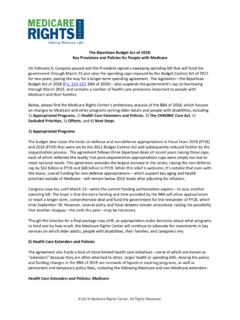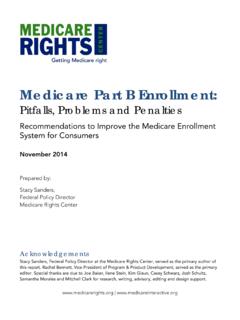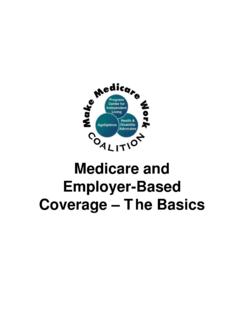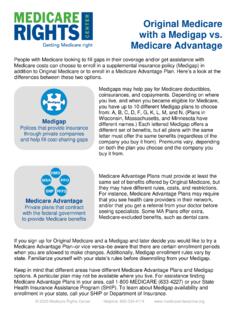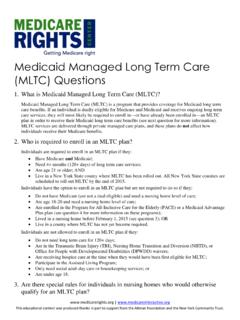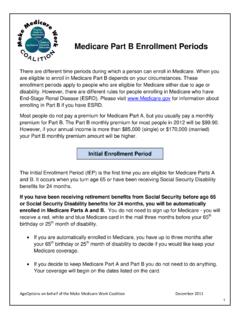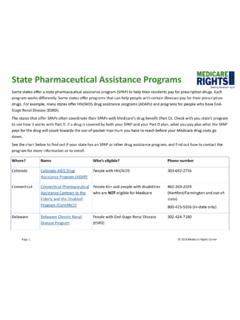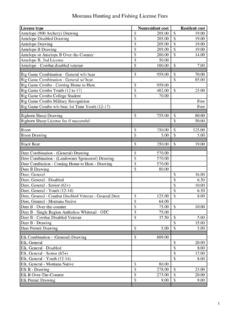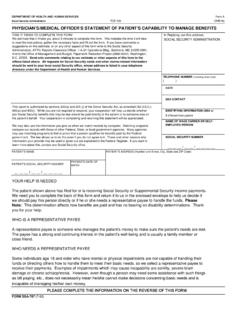Transcription of FACT SHEET: Medicare Two-Year Waiting Period for People ...
1 110 Maryland Ave Suite 112, Washington, DC 20002 Tel: (202) 544-5561 Fax: (202) 544-5549 FACT SHEET: Medicare Two-Year Waiting Period for People with Disabilities Background When Medicare expanded in 1972 to include individuals with significant disabilities, Congress stipulated that People with disabilities must first receive Social Security Disability Insurance (SSDI) for 24 months before gaining Medicare eligibility. This legislation was created to keep costs down and to avoid replacing coverage for a disabled worker still receiving benefits under a private group health plan. Individuals with disabilities must undergo a lengthy process before receiving Medicare coverage. First, the Social Security Administration must make a determination of SSDI approval. Second, individuals with disabilities must wait five-months before receiving SSDI benefits. Finally, after receiving their SSDI benefits, individuals must wait an additional 24 months before they receive Medicare coverage.
2 (Exceptions to the Waiting Period have been made for individuals with ALS, and for those with end-stage renal disease.) Facts and Figures An estimated million People with disabilities are caught up in this Waiting Period for Medicare . Since SSDI recipients are unable to work, they cannot access the principal source of coverage for People under 65 employer-sponsored insurance. Instead, People in the Medicare Waiting Period generally obtain coverage if they qualify for Medicaid, or if they can pay the premium to continue under their former employers plan under COBRA. According to a July 2003 Commonwealth Fund Report, nearly 39 percent of these individuals do not have health insurance coverage at some point during the Waiting Period and 24 percent have no health insurance during this entire Period . (Elimination of Medicare s Waiting Period for Seriously Disabled Adults: Impact on Coverage and Costs, The Commonwealth Fund, July 2003).
3 A study examining coverage during the Waiting Period for Americans aged 55-64 found that of those without coverage, about half were uninsured prior to the Waiting Period . The loss of employer coverage accounted for 36 percent of the uninsured, and 4 percent had lost the Medicaid coverage they had prior to the Waiting Period due to their SSDI cash benefit. (Transitioning to Medicare Before Sixty-Five, Health Affairs, March 2008). For those with COBRA or other private coverage at some point during the Waiting Period (58 percent of individuals 55-64) the costs are very high: For the first 18 months, the premium for continuing health insurance coverage through COBRA costs up to 102 percent of the total cost of coverage (full premium plus a 2 percent administrative fee). For those receiving the 11-month disability extension, the premium for these additional months may go up to 150 percent of the total cost of coverage (Transitioning to Medicare Before Sixty-Five, Health Affairs, March 2008).
4 It is common that during these 24 months, vulnerable individuals will lose their health insurance because they can no longer afford their COBRA or other private health insurance plans. Estimates for Medicaid coverage during the Waiting Period range widely (from 17 percent for individuals 55-64, to 40 percent in earlier research). Solution No one with disabilities severe enough to qualify for SSDI should be without health insurance. The Ending the Medicare Disability Waiting Period Act of 2009, sponsored by Senator Jeff Bingaman (S. 700) and Rep. Gene Green ( 1708) phases out Medicare s Two-Year Waiting Period over a 10 year span. The phase out initially reduces the wait to 18 months, and then reduces it by 2 months every year over 10 years. The bill also would immediately eliminate the wait for People with life-threatening illnesses as determined by the Secretary of Health and Human Services.
5 The legislation also advises the HHS Secretary, when compiling the list of life threatening diseases, to consult the Social Security Administration s Compassionate Allowance list which was created to provide benefits quickly to applicants whose medical conditions are so serious that their conditions obviously meet disability standards. Eliminating the 24-month Medicare Waiting Period for individuals who qualify for SSDI will cost the federal government $113 billion over ten years, while decreasing federal Medicaid spending by about $32 billion over the same Period . This option would boost tax revenue by about $3 billion over the 10 year span because of lower health insurance costs for employment-based plans, bringing the net deficit to about $110 billion. Reducing the wait for Medicare coverage to 12 months would cost $65 billion, according to a recent analysis of health policy options by the Congressional Budget Office (Budget Options, Volume 1, Health Care, Congressional Budget Office, December 2008).
6 When instituted in 1972 the Waiting Period was intended to limit Medicare costs. However, providing health insurance to those in the Waiting Period may reduce Medicare spending on these individuals over the long term. Many individuals forgo medical treatments, stop medications, and further compromise their health during these 24 months, which can lead to higher costs of care once covered. Tragically, 4 percent die during their wait for Medicare coverage. A study examining previously uninsured adults who enroll in Medicare because of age, found these individuals required more intensive and costlier care than those previously insured: Previously uninsured individuals reported 20 percent more hospital visits Medical expenditures were times higher than previously insured adults. (Use of Health Services by Previously Uninsured Medicare Beneficiaries, New England Journal of Medicine, July 2007) It is time to work to eliminate this wait to provide a healthier foundation for an already sick population.
7
